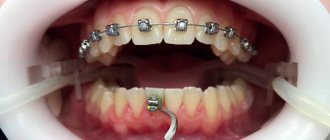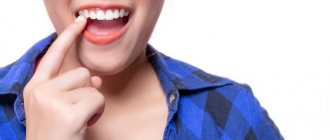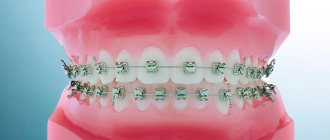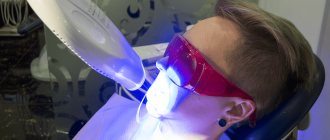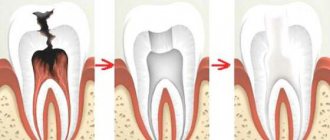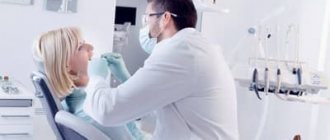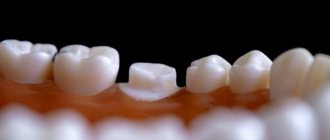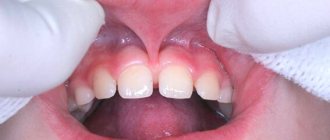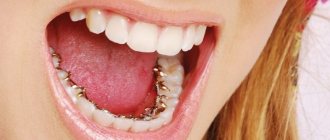Installation of braces – this is only the beginning of treatment, the main thing happens after. For effective treatment, periodic tightening of the braces, or rather the arch, and even its replacement is necessary. At the initial stage orthodontic treatment
thinner and more elastic arcs are used for delicate effects, which in the next stages are changed to more rigid and durable ones.
It is this process, the activation of braces
, that ultimately helps change the position of the teeth to the correct one.
Attention! Braces are tightened by the same orthodontist who initially installed the braces. It is not recommended to change specialist. The entire treatment process must be carried out under the strict supervision of one orthodontist.
What are braces
Braces are a non-removable orthodontic structure for the correction of developmental defects of the dentofacial apparatus. The bracket system consists of two main parts and fastening elements:
- • bracket plates attached using an adhesive composition to tooth enamel; • guiding power arc, which creates mechanical pressure on the teeth; • fasteners: ligatures (rubber rings or metal wire) or miniature locks. If ligatures are used, then the braces are called ligature. If the clasps are ligature-free (self-ligating).
About the manufacturer
Vitor braces are a product of the Chinese company Astar Orthodontics, which specializes mainly in orthodontic fixed systems. Astar has been supplying products to the dental market for about 15 years.
The company produces:
- metal and ceramic, vestibular and lingual braces of various designs and sizes, for both children and adults;
- nickel-titanium arcs;
- springs and elastic rods;
- bandage rings and other components.
Astar Orthodontics braces are made from the same materials and using the same technologies as orthodontic products from well-known brands.
Vitor systems are distinguished by good quality combined with affordable prices. They comply with European (CE) and American (FDA) standards, as well as the requirements for orthodontic products in Russia.
The company's head office is located in Shanghai, and its subsidiaries are in Hangzhou.
What is special about Evolution braces and how effective they are.
Come here to take a closer look at the design of Iconix braces.
At this address https://orto-info.ru/sistemyi-vyiravnivaniya-zubov/breketyi/po-tipu-materiala/metallicheskie/discovery.html all about the types and capabilities of Discovery braces.
Indications for treatment with braces
Like any treatment, indications for orthodontic therapy must be determined by a doctor. Installation of braces is indicated if the following conditions exist:
- malocclusion when the dentofacial apparatus is formed;
- occlusion defects that appear during the period of mixed dentition;
- deviations from the correct growth vector of individual dental elements;
- in preparation for prosthetics (classical or implantation) if tooth extraction causes the remaining elements to shift to the vacant space;
- crowding or, on the contrary, gaps between teeth (diastemas and trema);
- tilting the dental elements forward or backward;
- micrognathia (reduced jaw size).
Sometimes the disorders are clearly expressed, but often only a specialist can notice the pathology. Contacting an orthodontist is necessary in order to promptly identify an anomaly in the development of the dental system and eliminate it.
What is the bite like?
Occlusion - the position of the upper and lower dentition in the position of central occlusion. All types of bite can be divided into physiological and pathological.
Physiological:
- Orthognathic is the “ideal” variant of the bite, which is characterized by tight contacts between the teeth and dentition, as well as overlapping of the lower dentition by 1/3 of the crown;
- Biprognathic - a bite in which the crowns of the teeth are directed towards the vestibule of the mouth;
- Progenic – a bite characterized by a slight protrusion of the lower jaw forward;
- Direct - a type of bite in which, in the position of central occlusion, the upper and lower dentition touch the cutting edges.
These types of occlusion are allowed as variants of the norm of mutual arrangement of the dentition, since they are not capable of leading to functional disorders of the dentoalveolar system.
Pathological:
- Mesial – a bite characterized by protrusion of the lower jaw forward;
- Distal - a bite in which the upper jaw is more massive than the lower jaw;
- Deep - a bite in which the upper teeth strongly overlap the lower ones;
- Crossbite - a bite in which individual teeth of the lower jaw overlap the upper teeth in a separate area;
- An open bite is a bite in which gaps are formed between the closed teeth.
Pathological types of occlusion cause functional disorders in the dental system, and also, in some cases, disrupt the aesthetics of a smile.
Only an experienced orthodontist can most accurately determine the type of bite and draw up a treatment plan. Request an appointment in Moscow with Irina Aleksandrovna Butorina. The specialist has many years of experience, as well as more than a thousand satisfied patients.
Contraindications for installing braces
Even if there are indications for orthodontic correction using a brace system, it happens that such therapy may be contraindicated for a particular patient. Prohibitions are divided into relative and absolute. Relative restrictions include those that are temporary, for example, the acute course of a disease.
Relative contraindications:
- periodontal diseases;
- dental diseases (caries, pulpitis, etc.);
- pregnancy;
- bruxism.
Absolute contraindications:
- partial edentia (absence of a large number of teeth);
- oncology;
- osteoporosis and other bone diseases;
- mental illness;
- endocrine diseases;
- HIV AIDS;
- tuberculosis.
Advantages and disadvantages
The advantages of Vitor braces are due to thoughtful designs, modern manufacturing technology and strict quality control.
The entire line is characterized by:
- strength and reliability of the design , the ability to use maximum moving forces thanks to the use of high-quality stainless steel;
- high efficiency due to passive self-ligation and easy sliding of the arc relative to the groove;
- Comfort for the patient thanks to the ergonomic design , compact size and rounding of all contours;
- strong fixation on the teeth (provided by the anatomical shape of the base and 80-mesh mesh);
- the ability to use active alloying at the final stages (there are wings for installing the alloy);
- Convenient installation and removal of the archwire thanks to the shaped groove and the lightweight and easy-to-use locking clip.
Thanks to all of the above features, Vitor systems meet all the requirements for modern braces. There are no noteworthy shortcomings.
We can only mention the characteristic visibility of all metal braces on the teeth and the potential (rare) possibility of causing allergies in patients with individual intolerance to certain metals.
Types of bracket systems
In dentistry, bracket systems are usually divided into types depending on the main classifying characteristics: location on the dental rows, material of manufacture, presence of ligatures.
Depending on the place of fixation, braces are:
• vestibular – installed on the outer surface of the dentition; • lingual – attached to the teeth from the tongue side.
Depending on the material of manufacture:
- • metal; • ceramic; • sapphire; • combined.
Depending on the method of fixing the power arc on the bracket plates:
- • ligature, i.e. with fastening by means of ligatures (fastening parts in the form of rubber rings or metal wire); • non-ligating (self-ligating). In this case, the guide arc is fixed with small locks.
Material of manufacture
In terms of material, there are braces made of metal, ceramic, plastic and combined models. The peculiarities of the manufacturing material, the complexity of the clinical case, aesthetic requirements and financial capabilities allow the doctor and the patient to jointly decide which bracket system is better. There are no universal recommendations.
Ligature systems are made from a metal alloy (Orthos, Mini Diamond) and transparent artificially grown sapphire (aesthetic Inspire ICE). Aesthetic ligature braces are superior in size to metal structures. The disadvantage is more complex activation and an increased period of patient adaptation to foreign structures.
aesthetic sapphire Inspire ICE
Non-ligature structures are made of metal (Damon Q, Damon 3MX) and especially durable ceramics (Damon Clear 2). The adaptation period is easier than when installing devices with ligatures. Treatment with Damon systems is reduced by an average of 7 months compared to treatment with ligature braces.
teens with Damon Q braces
If psychological comfort or the characteristics of an adult patient’s profession require an inconspicuous system, it is advisable to choose Inspire ICE sapphire braces or Damon Clear 2 ceramic braces. For a child, sapphire and ceramic structures are not always a good choice due to increased fragility: a teenager can accidentally damage the elements of the system as a result injury or poor diet.
transparent Inspire ICE on typodont
Treatment algorithm
Therapy with braces is carried out in compliance with a specific protocol. Let's look at it step by step:
- diagnostics – identifying indications and contraindications, conducting hardware research to determine the complexity and characteristics of a specific clinical case. Performing an orthopantomogram (panoramic image), teleroentgenogram (x-ray image from a remote distance), as well as images in frontal, lateral and axial projection;
- taking dental impressions;
- drawing up a treatment plan;
- preparation for treatment - elimination of caries and inflammation of the oral cavity, professional teeth cleaning to remove soft plaque and hard deposits;
- fixing the finished brace system in the patient’s mouth;
- process of therapeutic influence (movement of dental elements). The duration of therapy depends on the individual and may last up to 24 months or longer. During treatment, the patient should regularly visit the orthodontist to adjust the position of the power guide arc;
- removal of braces upon achievement of results;
- wearing retention devices to consolidate the correction result. The duration of this stage is determined by the attending physician.
Teeth hurt after braces tightening
We hasten to reassure you: this is natural and normal, because the pressure increases, and some discomfort, as at the very beginning, after installing braces, is inevitable. However, you should immediately tell your doctor about severe pain - constant discomfort that does not go away the next day after the tightening cannot be felt. You don’t have to endure it if the wire of the braces interferes with you and you touch it with your gums or tongue.
Dentist advice:
Before the braces tightening procedure, it is better to think through your diet in advance for a day or two in advance - exclude food that needs to be chewed vigorously and leave something simpler, soft food (yogurt, cereal, puree);- It is better to eat and brush your teeth before the procedure - afterward, due to the sensitivity of the teeth, it will be more difficult;
- Talk to your doctor about what type of pain medication you can take if the pain bothers you. Important: do not take painkillers or anti-inflammatory drugs on an empty stomach;
- After meals, you can (and even should) use an antibacterial mouth rinse.
Why is it important to choose the right orthodontist?
Orthodontic treatment is long-term, it will last from a year or more, so the patient cannot immediately determine whether it is being treated well or not. If something in the treatment goes wrong due to the doctor’s fault, you will find out about it months, or maybe years, later. In order not to waste time, money, nerves and health, it is important to immediately choose a good orthodontist with whom you will also enjoy communicating for a long time. If you want to know our recommendations on how to do this so as not to regret it, read the article: “How and why to choose an orthodontist?”
Price issue
Vitor braces are supplied in sets of 20 pieces. The cost of one set ranges from 12 to 15 thousand rubles, which in terms of one brace equals 600-750 rubles. For comparison: one metal self-ligating bracket from the Diamond brand costs about 1,200 rubles.
The cost of a full course of treatment with Vitor braces, including, in addition to the cost of the systems, diagnostics, development of a treatment plan, installation, activation and removal of braces, ranges from 35 to 40 thousand rubles for two jaws.
RUSSIA
If all braces, without exception, correct your bite at the same rate, why pay more? Among those who want to achieve a perfect smile, there will definitely be those who will like this logic. These undemanding patients can with a clear conscience recommend Russian braces - reliable metal structures that guarantee excellent results. So far in our country there is only one manufacturer of devices for bite correction, but it has already managed to win the favor of several hundred thousand patients.
Pilot
A domestic company that produces metal vestibular brace systems of ligature type. Their cost is several times lower than that of foreign manufacturers, so these braces are most often used in Russia to correct the bite, effectively coping with all the tasks of orthodontic treatment. However, a significant disadvantage of these designs is that the patient has to change the ligatures every month and periodically change the metal arches.
GERMANY
The quality of many products made in Germany is admirable. Filigree precision, meticulous attention to detail, and the use of modern materials are strong arguments for choosing braces from German manufacturers.
TOP-Service für Lingualtechnik GmbH
The company has been operating since 1997. It produces the famous Incognito lingual braces, which are attached to the inside of the teeth and are invisible to others. These devices are manufactured individually for each patient on fully automated equipment using unique technology, so their cost is higher than that of any other types of braces.
Forestadent
Manufacturer of the first self-ligating braces. Initially, she was engaged in the manufacture of jewelry, so her orthodontic designs are distinguished by their particularly precise parameters and elegant design. Forestadent produces all types of braces, and their metal systems have been in demand among patients around the world for several decades. The excellent quality and effectiveness of Forestadent braces fully correspond to their high price.
